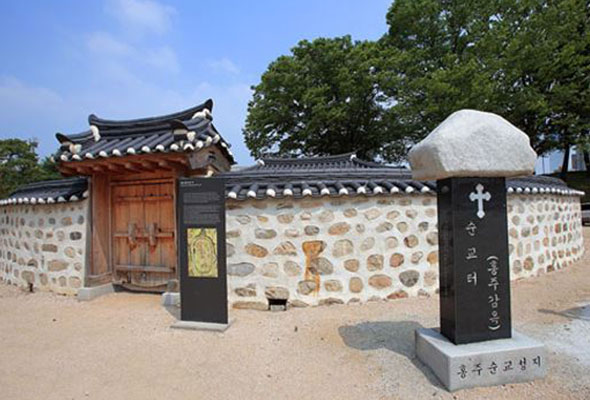The Land of Catholic Martyrs

Introduction and Characteristics of Catholicism
The Naepo region protrudes out to the sea, and this was the reason behind the development of multiple ports, contributing to its emergence as an important area for the transport of resources to the capital city. The openness and diversity of the maritime culture led to the introduction and rapid dissemination of Catholicism in the area. It was also the reason behind the invasion by Western powers. Thus, Catholics were oppressed and persecuted as a countermeasure in Joseon. The Naepo region was also the home of Andrew Kim Tae-gon, the first priest of Korea, as well as Father Choi Yang-eop.
Catholic Historic Sites
The Significance of Catholicism in Naepo
In the Naepo region, Catholicism was widely known even before its official introduction, evidence by the fact that there were those who practiced this region alone such as Hong Yu-han. In 1784, Lee Jon-chang from Yeosaul (Sinjong-ri, Sinam-myeon, Yesan-gun, Chungcheongnam-do) was baptized under the name Ludivico Gonzaga and became the first official Catholic in his hometown. Since then, Catholicism spread widely across the Naepo region, and then to other regions of the country from this ‘cradle of the Catholic faith.’
Cradle of the Catholic Faith
A wide variety of factors including various social factors as well as introspection by intellectuals, questioning of Confucianism, and desire for new ideas and concepts contributed to the rapid spread of Catholicism in Naepo and resulted in countless martyrs.
Types of Catholic Historic Sites
Of the Catholic historic sites in Naepo, there are 3 sites that have been identified in Hongseong.
It was where Catholics gathered to practice their faith and took refuge from persecution. It was also where they were later martyred.
A church smaller than the main Catholic church.
- Sugol
(Hongdong-myeon, Hongseong-gun) - Jaegyeonggol
(Singyeong-ri, Hongbuk-myeon, Hongseong=gun)
A place where Catholics were killed due to their religion
- Hongjuok
(former courthouse in Hongseong-eup)
Catholic Historic Sites
The Naepo region of Chungcheong-do Province, encompassing Hongseong, Yesan, Seosan and Boryeong, was one of the first places where the oppression of Catholics occurred. According to an appeal sent to Seungjeongwon in November 1791 (15th year of King Jeongjo's reign), historic research flourished in Boryeonghyun, where Yi Su-ha, a former Seungji, resided, and Hyeongam Yi Il-yun ordered a disciplinary action against some 10 people, which was proven ineffective. In 1794 (18th year of King Jeongjo's reign), a Chinese priest by the name of Ju Mun-mo entered Korea and while based in Seoul, he traveled to the rural areas for the purpose of propagating the Catholic faith. Records show that he traveled to Yeonsan, Gosan, Nampo of Hoseo, Onyang and Naepo.
Catholicism spread widely across the Naepo region including Hongseong-gun in the early days, and this was where two priests, Kim Tae-gon of Dangjin and Choi Yang-eop of Cheongyang, were from. Also, Dangjin became the biggest area of Catholic settlement in Korea.
As such, with the continuous spread of Catholicism in the Naepo region, the signs of oppression began to show in 1787 (11th year of King Jeongjo's reign). Over the course of 90 years, numerous Catholics in the area fled to the mountainous areas or relocated to faraway regions during the Sinyu Persecution (1801), Eulhae Persecution (1815), Gihae/Byeongo Persecution (1839, 1846), and Byeongin Persecution (1866).
According to the records, 331 men and 103 women (a total of 434 people) were martyred during these persecutions, and this accounted for 25% of the people who were martyred in Korea at the time. As for Hongseong-gun (then-Hongseong and Gyeolseong) in particular, there were 6 martyrs during the Sinyu Persecution, 1 during the Eulhae Persecution, 6 during the Byeongo Persecution and 117 during the Byeongin Persecution.
The Catholic churches in Hongseong-gun today belong to the Daejeon Diocese. The first Hongseong Catholic church was established in the 1950’s, while Gwangcheon-dong Catholic Church was established in 1968.
Information on the Catholics in Hongseong-gun (as of 2020)
| Church | Catholic believers (persons) | Number of leaders (persons) | Location | ||||
|---|---|---|---|---|---|---|---|
| Total | Male | Female | Total | Male | Female | ||
| Hongseong Catholic Church | 2,540 | 1,065 | 1,475 | 4 | 2 | 2 | 552-11 Goam-ri, Hongseong-eup |
| Gwangcheon-dong Catholic Church | 857 | 357 | 500 | 3 | 1 | 2 | 380 Sinjin-ri, Gwangcheon-eup |